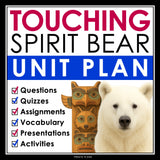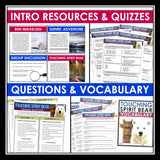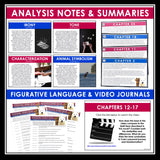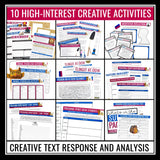Touching Spirit Bear Unit Plan - Ben Mikaelsen Novel Study Reading Unit
Digital Download
This comprehensive unit plan includes everything you need to teach Touching Spirit Bear with confidence and purpose. With over 350 pages and slides of engaging content, this ready-to-use resource will help your students explore the powerful themes, rich symbolism, and emotional depth of Ben Mikaelsen’s novel. From comprehension checks and vocabulary development to figurative language practice and literary analysis, each component is designed to foster meaningful learning while saving you hours of planning time.
Included in Touching Spirit Bear Unit Plan:
➡️ Touching Spirit Bear Introductory Presentation: This 18-slide PowerPoint presentation is the perfect way to introduce Touching Spirit Bear to your students. The slides build crucial background knowledge while encouraging student engagement and reflection.
Included in Touching Spirit Bear Unit Plan:
➡️ Touching Spirit Bear Introductory Presentation: This 18-slide PowerPoint presentation is the perfect way to introduce Touching Spirit Bear to your students. The slides build crucial background knowledge while encouraging student engagement and reflection.
➡️ Touching Spirit Bear Chapter Summary Cards: These 28 printable half-page cards break down the key plot developments and themes of each chapter in Touching Spirit Bear. They’re perfect for text-based discussions, a quick reference, or scaffolding support for students who need help tracking major events.
➡️ Touching Spirit Bear Quizzes: Assess understanding throughout the novel with five section-based quizzes, each with six multiple-choice questions and two short-answer quote analysis prompts. Detailed answer keys with explanations are provided for each quiz.
➡️ Touching Spirit Bear - Video Clip Journal Prompts: Encourage students to make meaningful connections to Touching Spirit Bear with these video journals. Each video relates to a central idea in the novel and is accompanied by a corresponding reflective writing prompt. Students draw text-to-self or text-to-world connections that deepen their engagement with the story.
➡️ Touching Spirit Bear Vocabulary Booklet and Slides: Help students build vocabulary through context. Students encounter unfamiliar words in quotes from the novel and use context clues to infer their meanings, and then confirm their definitions. Presentation slides for easy class review are included.
➡️ Touching Spirit Bear Questions and Answers: Guide students through the novel with a mix of comprehension and literary analysis questions organized by chapter section. The resource includes a student handout, printable response pages, and a presentation with evidence-based answers to support individual or group review.
➡️ Touching Spirit Bear Figurative Language Assignments: Students analyze literary devices such as metaphor, simile, personification, alliteration, oxymoron, and onomatopoeia through direct quotes from the novel. Five print-ready assignments are organized by chapter sections and include detailed answer keys for easy review.
➡️ Touching Spirit Bear Analysis Notes: This 49-slide PowerPoint presentation explores the novel’s core literary elements: theme, symbolism, conflict, tone, characterization, and more. Organized by chapter sections, the slides offer insightful commentary and examples that can be used for direct instruction, guided note-taking, or discussion prompts. These detailed notes will enhance students' understanding of the novel.
Touching Spirit Bear Unit Plan also includes creative assignments and activities for each reading section. You can learn more about what's included below:
Chapters 1–5:
➡️ Cole Matthews “I Am” Poem Activity: At the beginning of the novel, Cole is consumed by anger and blames everyone else for his problems. In this activity, students write an “I Am” poem from Cole’s perspective. At the end of the novel, they revisit the poem to capture how Cole has changed by rewriting their poem, allowing them to see his full transformation as a dynamic character in his own words.
➡️ Survival Pack Activity: When Cole destroys his supplies and burns his shelter, he loses essential tools for survival. This activity has students brainstorm what they would have brought in a survival pack and explain why.
➡️ Touching Spirit Bear Symbolism Assignment: Symbolism plays an important role in the novel, from the Spirit Bear itself to the at.óow blanket, fire, animals, and the island. In this activity, students track key symbols across chapters and analyze what they represent. By grounding their analysis in text evidence, they see how Ben Mikaelsen uses symbols to convey deeper themes of trust, anger, transformation, and healing.
➡️ Cole Matthews “I Am” Poem Activity: At the beginning of the novel, Cole is consumed by anger and blames everyone else for his problems. In this activity, students write an “I Am” poem from Cole’s perspective. At the end of the novel, they revisit the poem to capture how Cole has changed by rewriting their poem, allowing them to see his full transformation as a dynamic character in his own words.
➡️ Survival Pack Activity: When Cole destroys his supplies and burns his shelter, he loses essential tools for survival. This activity has students brainstorm what they would have brought in a survival pack and explain why.
➡️ Touching Spirit Bear Symbolism Assignment: Symbolism plays an important role in the novel, from the Spirit Bear itself to the at.óow blanket, fire, animals, and the island. In this activity, students track key symbols across chapters and analyze what they represent. By grounding their analysis in text evidence, they see how Ben Mikaelsen uses symbols to convey deeper themes of trust, anger, transformation, and healing.
Chapters 6–11:
➡️ Restorative Justice Lesson & Communication Circles: Teach students about the principles of restorative justice and learn about its Indigenous roots with this ready-to-use presentation. After this background, students participate in structured classroom communication circles modeled on the novel’s Circle Justice, focusing on important themes from the novel. Nonfiction articles and sentence stems are provided for each of the topics.
➡️ Restorative Justice Lesson & Communication Circles: Teach students about the principles of restorative justice and learn about its Indigenous roots with this ready-to-use presentation. After this background, students participate in structured classroom communication circles modeled on the novel’s Circle Justice, focusing on important themes from the novel. Nonfiction articles and sentence stems are provided for each of the topics.
Chapters 12–17:
➡️ At.óow Nonfiction Reading & Creative Blanket Design: The at.óow blanket given to Cole carries deep cultural and symbolic meaning. In this two-part activity, students first read a nonfiction article about the significance of the at.óow in Tlingit culture. Then, they design their own symbolic at.óow blanket, using color, pattern, and imagery to reflect their own style.
➡️ Imagery Analysis & Nature Writing Activity: Students learn how authors use sensory language to bring stories to life. With a presentation that breaks down the five types of imagery (sight, sound, smell, taste, touch), students practice analyzing vivid descriptive passages from Touching Spirit Bear. Using a graphic organizer, they highlight and categorize examples of imagery in the novel and reflect on how this shapes the reader’s experience. Finally, students head outside (or imagine a natural setting) to capture their own sensory details, then weave these into a descriptive paragraph that mirrors Cole’s growing connection to the natural world.
➡️ At.óow Nonfiction Reading & Creative Blanket Design: The at.óow blanket given to Cole carries deep cultural and symbolic meaning. In this two-part activity, students first read a nonfiction article about the significance of the at.óow in Tlingit culture. Then, they design their own symbolic at.óow blanket, using color, pattern, and imagery to reflect their own style.
➡️ Imagery Analysis & Nature Writing Activity: Students learn how authors use sensory language to bring stories to life. With a presentation that breaks down the five types of imagery (sight, sound, smell, taste, touch), students practice analyzing vivid descriptive passages from Touching Spirit Bear. Using a graphic organizer, they highlight and categorize examples of imagery in the novel and reflect on how this shapes the reader’s experience. Finally, students head outside (or imagine a natural setting) to capture their own sensory details, then weave these into a descriptive paragraph that mirrors Cole’s growing connection to the natural world.
Chapters 18–23:
➡️ Meditation Lesson & Reflection Activity: As Cole starts daily practices like cold plunges and carrying the ancestor rock, he discovers the importance of the mind-body connection. In this activity, students are introduced to the practice of meditation, exploring its history, benefits, and role in mindfulness. Students will participate in a video guided meditation and then reflect on the experience using structured discussion prompts.
➡️ Totem Pole History and Animal Carving Symbolism Activity: Students learn about the origins and cultural significance of totem poles from Indigenous peoples of the Pacific Northwest. Then, using a provided template, they create their own “identity pole” that reflects their identity through symbolic animal carvings based on what they learn about animal symbolism in different cultures.
➡️ Meditation Lesson & Reflection Activity: As Cole starts daily practices like cold plunges and carrying the ancestor rock, he discovers the importance of the mind-body connection. In this activity, students are introduced to the practice of meditation, exploring its history, benefits, and role in mindfulness. Students will participate in a video guided meditation and then reflect on the experience using structured discussion prompts.
➡️ Totem Pole History and Animal Carving Symbolism Activity: Students learn about the origins and cultural significance of totem poles from Indigenous peoples of the Pacific Northwest. Then, using a provided template, they create their own “identity pole” that reflects their identity through symbolic animal carvings based on what they learn about animal symbolism in different cultures.
Chapters 24–28:
➡️ Cole’s Scrapbook Project: In this creative project, students document Cole’s transformation throughout Touching Spirit Bear by building a scrapbook that captures pivotal moments in his journey. Pages will focus on the bear attack, cold plunges, ancestor rock, and the anger dance, with each entry including a journal reflection from Cole’s perspective, a meaningful quote, a symbolic object, and a visual element.
➡️ Final Essay Topics: Students conclude the unit by writing a final essay, choosing from ready-to-use prompts. The topics focus on central themes such as trust, responsibility, the role of nature, forgiveness, anger, symbolism, and personal growth.
© Presto Plans
➡️ Want 10 free ELA resources sent to your inbox? Click here!
➡️ Cole’s Scrapbook Project: In this creative project, students document Cole’s transformation throughout Touching Spirit Bear by building a scrapbook that captures pivotal moments in his journey. Pages will focus on the bear attack, cold plunges, ancestor rock, and the anger dance, with each entry including a journal reflection from Cole’s perspective, a meaningful quote, a symbolic object, and a visual element.
➡️ Final Essay Topics: Students conclude the unit by writing a final essay, choosing from ready-to-use prompts. The topics focus on central themes such as trust, responsibility, the role of nature, forgiveness, anger, symbolism, and personal growth.
© Presto Plans
➡️ Want 10 free ELA resources sent to your inbox? Click here!












